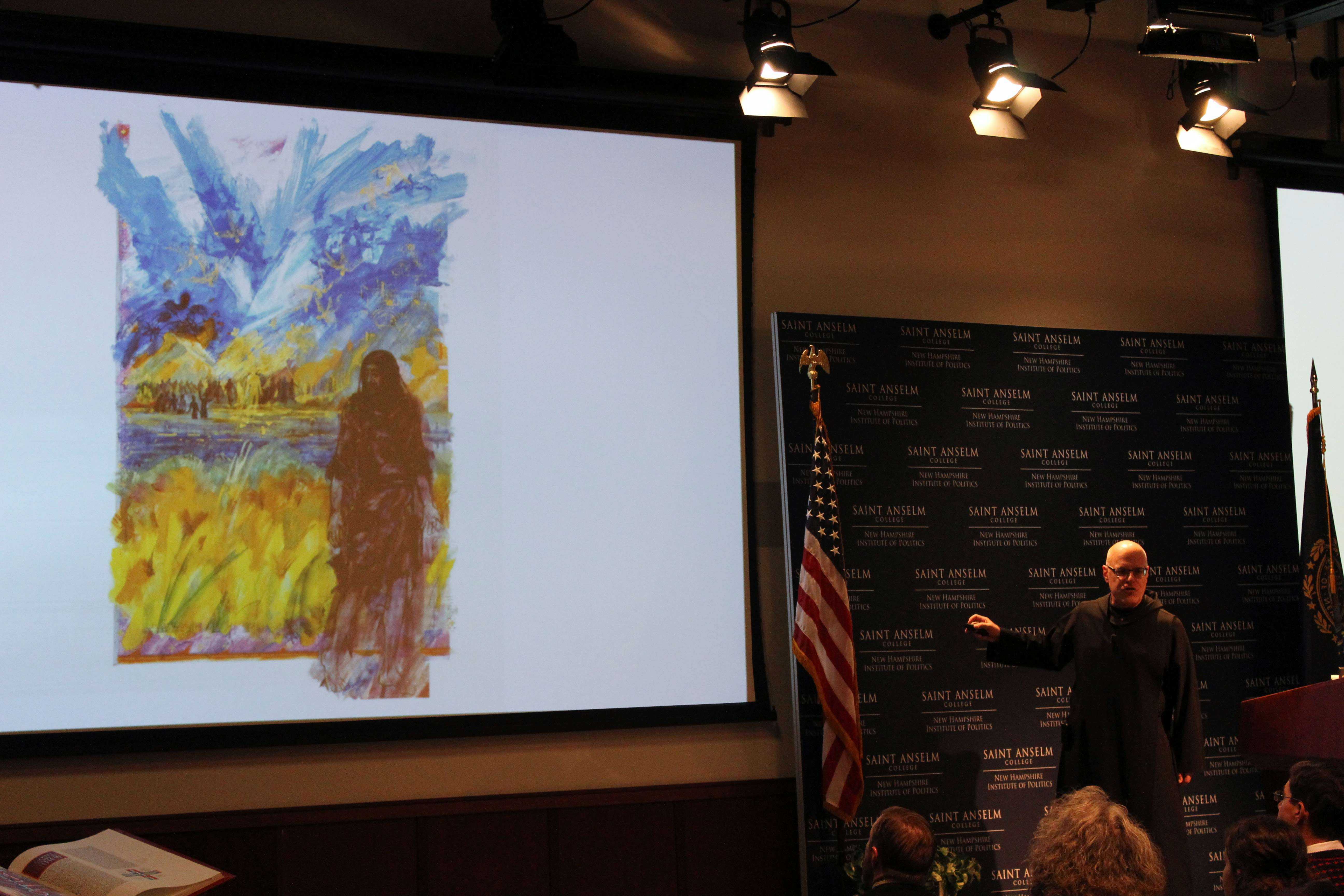Fr. Michael Patella, O.S.B., lectures on Saint John’s Bible at NHIOP
November 16, 2016
The Saint John’s Bible made a special appearance at the New Hampshire Institute of Politics (NHIOP) on Nov. 10. It was the first stop of a series of events celebrating the year that the Bible will be on campus at Saint Anselm College.
The lecture titled “The Saint John’s Bible: A Postmodern Interpretation of Sacred Scripture,” was given by Fr. Michael Patella, O.S.B., rector of the seminary at Saint John’s University. Father Patella was the chairman of the Committee on Illumination and Text for the project of The Saint John’s Bible. He served as such from the beginning of the project in the summer of 1996 all the way through its completion in June of 2011 and beyond.
Br. Isaac S. Murphy, O.S.B., vice president of academic affairs, introduced Fr. Patella to a rather large crowd. Br. Isaac immediately expressed his excitement for the turnout for the event, which filled out nearly all of the NHIOP.

Fr. Patella O.S.B. speakeing at the NHIOP.
Fr. Patella started with a short introduction explaining his understanding of the definitions of modernity, canonical criticism, postmodern intertextuality, and synesthesia. Using images of The Saint John’s Bible projected onto the monitors in the auditorium, Fr. Patella went into thorough detail explaining 40 pages of the Bible and their significance to the themes of modernity, canonical criticism, postmodern intertextuality, and synesthesia.
The lecture was very interactive, as Fr. Patella transformed the lecture into a classroom-like setting. He asked the crowd many questions, keeping them thoroughly engrossed in the subject.
Images included in his presentation were pages that displayed the Genealogy of Jesus, The Baptism of Jesus, Peter’s Confession, Sower and the Seed, Luke’s Anthology, the Raising of Lazarus, and Jacob’s ladder.
A page that Fr. Patella spent some extra time on was one that portrayed the twin towers that stood tall in New York City until the fateful day of Sept. 11, 2001. This page is known as Luke’s Anthology. He explained that the artists of this page—Donald Jackson, Aidan Hart, and Sally Mae Joseph—were in the midst of completing this image on that fateful day and they decided to include the likeness of the towers in the Bible. The reason that Fr. Patella gave for the inclusion of the towers was, “Forgiveness is the only way out [of this world].”
When asked by the crowd why exactly Saint John’s took on the challenge of creating this Bible, Fr. Patella simply stated: “the millennia.”

Fr. Patella O.S.B. describes 20 illustrations from the Bible to the packed NHIOP.
Here, Fr. Patella referred to the Great Jubilee Year of 2000 called by Saint John Paul II. In the Roman Catholic tradition, a Holy Year, or Jubilee is a year of forgiveness of sins and also the punishment due to sin; it is a year of reconciliation between adversaries, of conversion and receiving the Sacrament of Reconciliation, and consequently of solidarity, hope, justice, commitment to serve God with joy and in peace with others. A Jubilee year is above all the year of Christ, who brings life and grace to humanity. The Jubilee Year of 2000 was the start of the third Christian millennium.
Many students and community members stayed after Fr. Patella’s lecture in order to get an up close and personal look at the Bible with both him and Br. Isaac. Keith Chevalier, the college archivist, was also in attendance and was the man in charge of showing the Bible to the crowd after the lecture ended.
“I am absolutely fascinated by the Bible and feel so grateful that Saint Anselm is its home for the entire year,” says Emily Craig ’19. “Fr. Patella’s presentation illuminated the postmodern intention of the work’s illustration.
Br. Isaac closed by saying that the college was honored to host Fr. Patella and voiced his excitement to feature the Bible this year.


